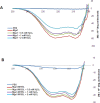Mge1, a nucleotide exchange factor of Hsp70, acts as an oxidative sensor to regulate mitochondrial Hsp70 function
- PMID: 23345595
- PMCID: PMC3596242
- DOI: 10.1091/mbc.E12-10-0719
Mge1, a nucleotide exchange factor of Hsp70, acts as an oxidative sensor to regulate mitochondrial Hsp70 function
Abstract
Despite the growing evidence of the role of oxidative stress in disease, its molecular mechanism of action remains poorly understood. The yeast Saccharomyces cerevisiae provides a valuable model system in which to elucidate the effects of oxidative stress on mitochondria in higher eukaryotes. Dimeric yeast Mge1, the cochaperone of heat shock protein 70 (Hsp70), is essential for exchanging ATP for ADP on Hsp70 and thus for recycling of Hsp70 for mitochondrial protein import and folding. Here we show an oxidative stress-dependent decrease in Mge1 dimer formation accompanied by a concomitant decrease in Mge1-Hsp70 complex formation in vitro. The Mge1-M155L substitution mutant stabilizes both Mge1 dimer and Mge1-Hsp70 complex formation. Most important, the Mge1-M155L mutant rescues the slow-growth phenomenon associated with the wild-type Mge1 strain in the presence of H2O2 in vivo, stimulation of the ATPase activity of Hsp70, and the protein import defect during oxidative stress in vitro. Furthermore, cross-linking studies reveal that Mge1-Hsp70 complex formation in mitochondria isolated from wild-type Mge1 cells is more susceptible to reactive oxygen species compared with mitochondria from Mge1-M155L cells. This novel oxidative sensor capability of yeast Mge1 might represent an evolutionarily conserved function, given that human recombinant dimeric Mge1 is also sensitive to H2O2.
Figures







Similar articles
-
Methionine sulfoxide reductase 2 reversibly regulates Mge1, a cochaperone of mitochondrial Hsp70, during oxidative stress.Mol Biol Cell. 2015 Feb 1;26(3):406-19. doi: 10.1091/mbc.E14-09-1371. Epub 2014 Nov 26. Mol Biol Cell. 2015. PMID: 25428986 Free PMC article.
-
A Single Point Mutation in Mitochondrial Hsp70 Cochaperone Mge1 Gains Thermal Stability and Resistance.Biochemistry. 2016 Dec 27;55(51):7065-7072. doi: 10.1021/acs.biochem.6b00232. Epub 2016 Dec 15. Biochemistry. 2016. PMID: 27977164
-
A conserved R type Methionine Sulfoxide Reductase reverses oxidized GrpEL1/Mge1 to regulate Hsp70 chaperone cycle.Sci Rep. 2018 Feb 9;8(1):2716. doi: 10.1038/s41598-018-21083-9. Sci Rep. 2018. PMID: 29426933 Free PMC article.
-
Molecular chaperones as essential mediators of mitochondrial biogenesis.Biochim Biophys Acta. 2002 Sep 2;1592(1):51-62. doi: 10.1016/s0167-4889(02)00264-1. Biochim Biophys Acta. 2002. PMID: 12191768 Review.
-
[Mitochondrial Hsp70 - function and evolution].Postepy Biochem. 2016;62(2):69-76. Postepy Biochem. 2016. PMID: 28132457 Review. Polish.
Cited by
-
Redox regulation of GRPEL2 nucleotide exchange factor for mitochondrial HSP70 chaperone.Redox Biol. 2018 Oct;19:37-45. doi: 10.1016/j.redox.2018.07.024. Epub 2018 Aug 4. Redox Biol. 2018. PMID: 30098457 Free PMC article.
-
Quantitative proteomics of the yeast Hsp70/Hsp90 interactomes during DNA damage reveal chaperone-dependent regulation of ribonucleotide reductase.J Proteomics. 2015 Jan 1;112:285-300. doi: 10.1016/j.jprot.2014.09.028. Epub 2014 Oct 18. J Proteomics. 2015. PMID: 25452130 Free PMC article.
-
Molecular modeling of the binding modes of the iron-sulfur protein to the Jac1 co-chaperone from Saccharomyces cerevisiae by all-atom and coarse-grained approaches.Proteins. 2015 Aug;83(8):1414-26. doi: 10.1002/prot.24824. Epub 2015 Jun 6. Proteins. 2015. PMID: 25973573 Free PMC article.
-
Comparative analysis of mitochondrion-related organelles in anaerobic amoebozoans.Microb Genom. 2023 Nov;9(11):001143. doi: 10.1099/mgen.0.001143. Microb Genom. 2023. PMID: 37994879 Free PMC article.
-
Preferential binding of ADP-bound mitochondrial HSP70 to the nucleotide exchange factor GRPEL1 over GRPEL2.Protein Sci. 2024 Nov;33(11):e5190. doi: 10.1002/pro.5190. Protein Sci. 2024. PMID: 39445986 Free PMC article.
References
-
- Azem A, Oppliger W, Lustig A, Jeno P, Feifel B, Schatz G, Horst M. The mitochondrial hsp70 chaperone system. Effect of adenine nucleotides, peptide substrate, and mGrpE on the oligomeric state of mhsp70. J Biol Chem. 1997;272:20901–20906. - PubMed
-
- Bulteau AL, Ikeda-Saito M, Szweda LI. Redox-dependent modulation of aconitase activity in intact mitochondria. Biochemistry. 2003;42:14846–14855. - PubMed
-
- Cocheme HM, Murphy MP. Complex I is the major site of mitochondrial superoxide production by paraquat. J Biol Chem. 2008;283:1786–1798. - PubMed
Publication types
MeSH terms
Substances
LinkOut - more resources
Full Text Sources
Other Literature Sources
Molecular Biology Databases

